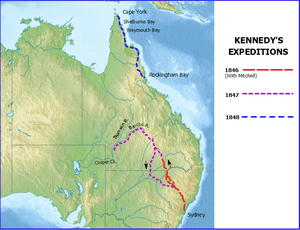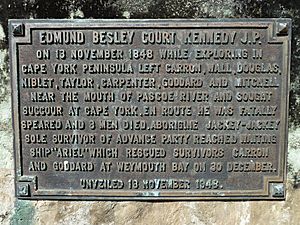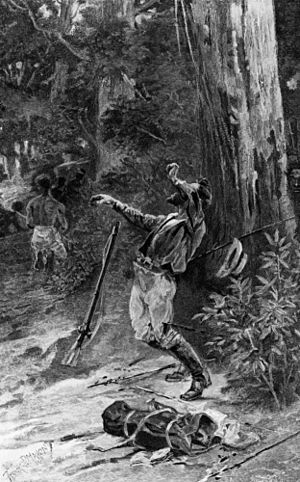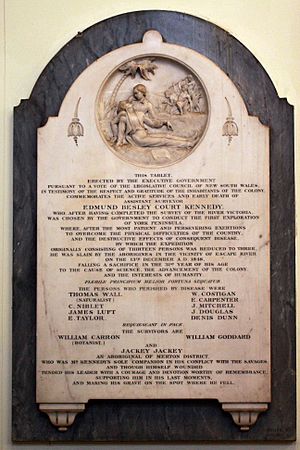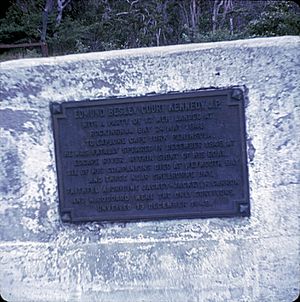Edmund Kennedy facts for kids
Quick facts for kids
Edmund Kennedy
|
|
|---|---|
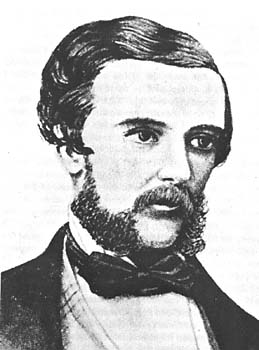
Drawing of Edmund Kennedy
|
|
| Born | 5 September 1818 |
| Died | December 1848 Cape York, Queensland, Australia
|
| Cause of death | Speared |
| Nationality | British |
| Alma mater | Elizabeth College, Guernsey |
| Occupation | Explorer, Public Servant Surveyor |
| Employer | Surveyor-General's Department State of New South Wales |
| Known for | Exploration |
| Parent(s) | Colonel Thomas Kennedy & Mary Ann |
Edmund Besley Court Kennedy (born September 5, 1818 – died December 1848) was an important explorer in Australia. He worked as an Assistant-Surveyor for New South Wales. He helped Sir Thomas Mitchell on his expeditions. Kennedy explored parts of Queensland and northern New South Wales. His journeys included the Thomson River, the Barcoo River, Cooper Creek, and Cape York Peninsula. Sadly, he died in December 1848 near Cape York after being speared by Aboriginal Australians.
Contents
Early Life and Training
Edmund Kennedy was born on September 5, 1818, on Guernsey, one of the Channel Islands. His parents were Colonel Thomas Kennedy and Mary Ann Kennedy. He was one of nine children in his family.
Edmund went to school at Elizabeth College in Guernsey. From a young age, he was very interested in surveying, which is the skill of measuring and mapping land. In 1837, he worked in Rio de Janeiro, Brazil. He returned to England in 1838 when his workplace closed.
A family friend, Captain Charles James Tyers, suggested that Edmund could find work in Australia if he learned more about surveying. So, in 1839, Edmund took classes in surveying at King's College London and earned a certificate.
In November 1839, Kennedy sailed to Sydney, Australia, on a ship called the Globe. He arrived in March 1840. Another family friend, Captain Perry, who worked with Sir Thomas Mitchell, helped Edmund get a job. After passing an exam, Edmund became an assistant surveyor in the New South Wales Survey Department. In August, he joined Captain Tyers on a trip to Melbourne and then to Portland Bay for surveying work.
While in Portland Bay, he met Margaret Murphy and they had a daughter. Sadly, their daughter Eliza died when she was five years old. Edmund became very skilled in his surveying work during this time. However, a disagreement with a local official led to him being called back to Sydney in May 1843. Even so, his work was highly praised, and Sir Thomas Mitchell thought highly of him. Mitchell soon chose him for an important new expedition.
First Big Expedition
In 1845, Sir Thomas Mitchell got permission to lead a big expedition. The goal was to travel from Sydney all the way to the Gulf of Carpentaria in northern Australia. Mitchell believed a large river flowed northwest to the gulf, and he wanted to find it. Edmund Kennedy was chosen to be his second-in-command.
The expedition started from Sydney in mid-November. It was a very large group: 30 men, enough supplies for 12 months, 8 drays (carts), 3 smaller carts, 102 bullocks, 255 sheep, and 17 horses. Because the group was so big, they moved very slowly.
Mitchell led the group north along the Bogan River, then east to the Macquarie, and north to the Narran. They then followed the Balonne. Near the modern town of St George, Queensland, Mitchell found a natural rock crossing and named it St George Bridge. He left Kennedy and the main group at a camp for three weeks to rest the animals. Kennedy was to follow slowly while Mitchell explored ahead with a smaller team.
Mitchell continued along the Balonne, which took him too far northeast. He then turned west and found the Maranoa River. Kennedy and the main group caught up on June 1, 1846. Mitchell realized their heavy equipment was slowing them down too much. So, he decided to leave Kennedy behind again, near where the town of Mitchell is today. Mitchell was gone for four and a half months.
Mitchell explored the Maranoa River to its source. He found an area of hills with many streams, but none flowed northwest towards the gulf. He left another small group behind and traveled northwest with only a guide and two men. Finally, he found a large river that seemed to flow towards the gulf. He named it the Victoria River, after the British Queen. Mitchell had run out of supplies and had to turn back. The smaller teams rejoined, and they returned to Kennedy's camp on October 19. The whole expedition then headed back to Sydney, arriving on January 20, 1847.
Second Expedition
Mitchell was very impressed with Kennedy's leadership skills. He also admired Kennedy's knowledge of surveying and exploration. Since the question of a great northwest river was still unanswered, Mitchell got approval for a new expedition in February 1847. This time, the main goal was to map the course of his Victoria River. Mitchell put Kennedy in charge of this new group of eight men. They left Windsor, New South Wales on March 21, 1847.
Kennedy's instructions were to travel to St. George Bridge and then to the Maranoa River, where his earlier camp had been. From there, he was to map the Victoria River. Kennedy had studied Mitchell's map and noticed that the Victoria River seemed to turn towards a bend in Cooper Creek, which explorer Charles Sturt had named in 1845.
The expedition continued north into new territory for Kennedy. By mid-August, they were near the area where Mitchell had been forced to turn back. Kennedy decided to hide their carts and supplies from local Aboriginal people by burying them in a large trench. Then, they continued their journey using packhorses.
The river they were following began to turn southwest, taking them away from the gulf. Kennedy scouted ahead and found a large river joining the Victoria from the north. He named it the Thomson River to honor the Colonial Secretary, Mr. Edward Deas Thomson. The land became very difficult to travel through. By early September, Kennedy had to go back to his hidden supplies because they were running out of water and food. The river still showed no sign of turning towards the gulf; it looked like it would flow into Cooper Creek. Kennedy then planned to split his group and make a quick dash for the gulf.
However, when they opened a buried cart, they found that local people had tampered with it. Many of their supplies were destroyed. This meant the expedition had no choice but to return to Sydney. On the way back, Kennedy followed the Warrego River (which Mitchell had discovered in 1846). But its course took him too far west, splitting into many small channels. He then headed east, found the Culgoa River, and returned to Sydney on February 7, 1848. It was later proven that the Victoria River did flow into Cooper Creek. It was then renamed the Barcoo River, an Aboriginal name that Kennedy had learned.
Third Expedition and Final Journey
The government's plan for Kennedy's next journey was to find a route to the Gulf of Carpentaria. After that, he was to explore Cape York Peninsula. Port Essington was the only port in northern Australia at the time, but trade between Sydney and Singapore was growing. Captain Owen Stanley of HMS Rattlesnake suggested exploring the east coast of Cape York first. He thought that after getting more supplies at the tip of the cape, the exploration could continue down the west coast. Then, the group could return overland to Sydney. They expected the trip to take about eighteen months. This idea was accepted, and planning began for Kennedy to start at Rockingham Bay, near the modern town of Cardwell, Queensland.
On April 28, 1848, Edmund Kennedy and twelve men sailed from Sydney Harbour on the ship Tam O' Shanter. They were escorted by the Rattlesnake. They arrived at Rockingham Bay on May 20. But once they landed, the party faced terrible land. There were mangrove swamps, mountains, lagoons, rivers, and thick rainforest. It was almost impossible to travel with horses, carts, and sheep. After nine weeks, they had only traveled 40 miles from the coast. Kennedy had to leave the carts and some supplies behind in a hopeless bog. Later, they found that the storeman had stolen food, so he was made a laborer. The group was supposed to meet a supply ship called Bramble at Princess Charlotte Bay in early August. But they were two months late, and the ship couldn't get close to the shore anyway.
Kennedy's Death
By mid-November, the men and horses were getting very weak. So, Kennedy decided to leave eight men behind at Weymouth Bay. Kennedy and four others continued north. They still had hundreds of miles to go to meet another supply ship, the Ariel, to get rescued. Days after crossing the Pascoe River, near Shelburne Bay, one of the men, Costigan, accidentally shot himself while taking care of his horse. He couldn't continue. So, Luff and Dunn were left behind to care for him. They were never seen again.
Kennedy and his Aboriginal tracker, Jackey Jackey, pushed on towards Port Albany. But local Aboriginal people were following them closely. Near the banks of the Escape River, about 20 miles from the tip of Cape York, Kennedy was speared several times. He died in Jackey Jackey's arms. Reports suggest that Kennedy's death was not directly provoked. After an amazing journey of about ten days with no supplies, Jackey Jackey reached the supply ship alone on December 23, 1848.
Following Jackey Jackey's directions, the Ariel went to Shelburne Bay. A search party went ashore and found a few items, but no sign of the three men left behind. The ship continued to Weymouth Bay. There, William Carron and William Goddard were found to be the only survivors of the eight men left there. The Ariel, with its three surviving explorers, returned to Sydney in May 1849.
Legacy and Memorials
Many places and things were named in honor of Edmund Kennedy:
- The former Electoral district of Kennedy in the Queensland Legislative Assembly and the Division of Kennedy in the Parliament of Australia are named after him.
- Edmund Kennedy National Park was created in 1977.
- The Kennedy Highway is named after him.
- Kennedy, Queensland is a town in the Cassowary Coast Region.
In 1852, a marble memorial to Kennedy was placed in St James' Church in Sydney. It shows Kennedy dying in Jackey Jackey's arms.
100-Year Commemoration
The 100th anniversary of Kennedy's expedition was remembered in 1948.
- In May 1948, a monument to Kennedy was put up in Cardwell.
- On September 25, 1948, another monument to Kennedy was placed in Cooktown.
- On November 11, 1948, a monument was erected at Portland Road (Weymouth Bay) in Iron Range, Queensland. It is near a spring where the expedition got water.
- The Kennedy Memorial Monument was unveiled on December 13, 1948, in Somerset, Queensland. This was to mark 100 years since Kennedy's difficult exploration of Cape York Peninsula. The monument is a concrete slab with a bronze plaque on its eastern side.
Also, bronze plaques were placed in Charleville, Kennedy, Tully, and Escape River.


